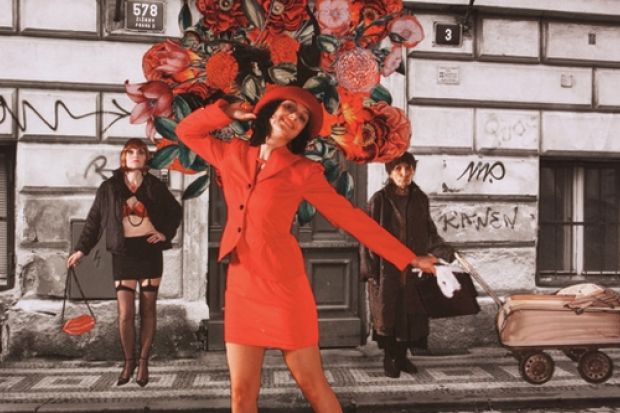Surviving Life (Theory and Practice)
Directed by Jan Švankmajer
Starring Václav Helsus, Klára Issová and Zuzana Krónerová
Released in the UK on 2 December
You close your eyes and find yourself in a city of symbols. You've been here before. This dreamscape is the place films go when they fall asleep.
This grey, cobbled European street, and the bleak apartments above it, resemble the locations from Luis Bunuel and Salvador Dalí's Un Chien Andalou (1929), and follow the same queasy, nightmare logic: an old woman pushes a stove in a pram, a man spits buttons into a pile. At every window, and down every alleyway, larger-than-life signifiers are lurking - a smashed egg, a watching face, giant scissors cutting a tie - like props from Dalí's later work on Alfred Hitchcock's Spellbound (1945) and his influence on Walt Disney's Alice in Wonderland (1951). The recurring close-ups of opening doors and keys in locks, leading us on repeated loops through the same dream cycle with minor variations, recall Maya Deren and Alexander Hammid's Meshes of the Afternoon (1943). The mysterious figure on a bench, offering explanations of a sort, could have wandered in from Robert Wiene's The Cabinet of Dr Caligari (1920) or David Lynch's Lost Highway (1997); the experiments with induced sleep and lucid dreaming are low-tech versions of the science-fiction scenarios from The Matrix, Inception and Eternal Sunshine of the Spotless Mind.
Jan Švankmajer has been here before, too. He introduces the film with a sardonic apology, claiming that his use of animated photographs and stop motion is the result of a lack of cash, but the rhythmic visual grammar of Surviving Life is straight out of his own Alice (1988). Anything closer than a mid-shot is rendered in live action, but long shots take place in a two-dimensional world of cut-outs and paper shapes. Flat, frantic depictions of human activity, from sex to suicide, are punctuated with large, unlovely close-ups of the characters' mouths pronouncing dialogue. The effect is much like the moving collages of the Beatles' 1968 film Yellow Submarine (directed by George Dunning) and Terry Gilliam's cartoons for Monty Python's Flying Circus (1969-74). It feels oddly dated, like a relic from 30 years ago.
The set-up is, disappointingly, like a 1970s sex comedy without the laughs. The protagonist, Eugene, falls for a woman in his dreams and tries to pursue her by staying asleep and steering his own nocturnal fantasies. His waking life is structured by a boring office job, trips to his psychoanalyst - who at one point tries to seduce him - and comfortably dull domestic evenings with his wife. That Eugene's reality is just as stylised as his dream world - his days are made up of the same cut-out puppets and cardboard environments as his nights - reduces the film to an undifferentiated aesthetic that quickly wears thin. This is an Alice without imagination; an art-house Inception that, unlike Christopher Nolan's film, shows us nothing new.
While the dream sequences initially offer visual puzzles and invite interpretation, this small pleasure is denied us by the scenes directly afterwards where the psychoanalyst ploddingly explains them in detail. When she asks: "Do you know the story of King Oedipus?" your heart sinks. Surely every viewer of a Švankmajer film in a small Soho cinema - surely every viewer of a Michael Bay blockbuster at the Odeon up the road - has heard this one before. But she explains it anyway, as snakes slither on cue between buildings, apples roll dutifully out of doorways and hands grab at naked women with cockerel heads. A Greek chorus is provided by portraits of Jung and Freud, and interpretations are drawn from their texts of more than a century ago. Švankmajer, you remember, is 77 years old.
The Pythons produced sharper parodies of lust and libido in the 1970s. Hitchcock was lighter and wittier in his flirtation with dime-store Freudian theory in the 1940s. The greatest irony is, perhaps, that there is clearly another, more interesting film to be made about Eugene and his world of municipal buildings, empty buses, old elevators, run-down apartments, dumplings and goulash. This is a city of warehouses labelled "purchase and collection" (výkup sberna) and the dismal World Cinema (Kino Svet); a city of waltzes played on cassette players, of getting by and making do. There is another film to be made about this city and its people; but perhaps Švankmajer is not the man to make it.
Register to continue
Why register?
- Registration is free and only takes a moment
- Once registered, you can read 3 articles a month
- Sign up for our newsletter
Subscribe
Or subscribe for unlimited access to:
- Unlimited access to news, views, insights & reviews
- Digital editions
- Digital access to THE’s university and college rankings analysis
Already registered or a current subscriber? Login
